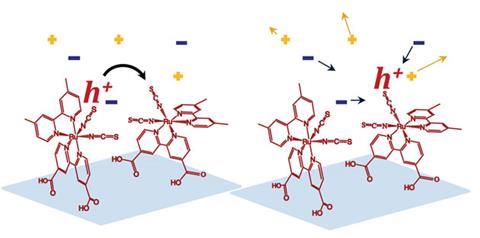Researchers in the UK, Spain and Switzerland say a method they have developed for probing electron transfer reactions could help them design more efficient solar cells.
Monitoring the behaviour of charges in photovoltaic devices is important for improving charge collection, especially in dye sensitised solar cells (DSSCs) that convert sunlight to electricity. Creating efficient solar cells is pivotal for meeting increasing energy demands especially as the world looks to move away from fossil fuels. DSSCs have many attractive features being simple to make, flexible and transparent, but they still have a way to go in terms of efficiency.
A research team led by Piers Barnes of Imperial College London has pioneered a technique that measures the diffusion coefficient of a less well reported phenomenon known as hole hopping, which occurs between sensitised dye molecules anchored to surfaces (in this case TiO2).
Barnes explains that ‘when an excited electron in a sensitised molecule is transferred, it’s possible for the remaining electron hole to hop to another dye molecule’. This allows a charge to be transported across a surface via a kind of molecular wire. Barnes believes this is a highly accessible method because it uses simple cyclic voltammetry to measure variations in the diffusion coefficient with temperature, from which an estimate of the reorganisation energy for charge transfer between sensitiser molecules can be derived. By applying this to a range of well-known dyes, the features that lead to reduced reorganisation energies could be determined and new dyes devised.

Rachel Caruso an expert in photovoltaics at the University of Melbourne in Australia says that the ability to ‘specifically tailor the structure of molecules to enhance their charge transport properties is highly desirable’. She adds that this approach could have a large impact on the future synthesis of organic semiconductors in general.
Barnes agrees that an understanding of this ‘interesting phenomenon could be more widely applied in other devices,’ including batteries and transistors. For now, the group are testing dye cells using the highest hole hopping rate molecules to further refine their approach. Computational work is also on-going with the ultimate aim to screen candidate molecules without having to synthesise them first.






No comments yet